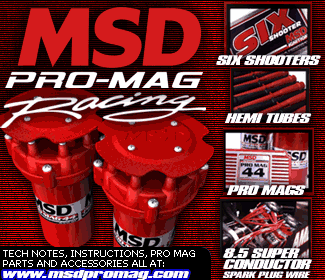
According to chassis builder Brad Hadman, the
immediate reaction after the crash was to mandate
a single-element wing and perhaps reduce the
nitro percentage from 90 percent to 80 percent.
Another suggestion being put forth is to reduce
the wing area from the current area of 1500
square inches to 1100 square inches. Hadman
is opposed to reducing the wing area thinking
that the wing area would have an adverse result.
He believes the current wing area contributes
a great deal to the cars going straight down
the track.
Another idea supposedly being considered is
to relocate the current wing forward and down
ten inches from its current location. According
to two wing experts, moving the location of
the wing in that manner would accomplish two
things: First, by taking the wing out of "clean"
air the current wings would then produce approximately
the same amount of down force as a single element
wing. Second, moving the rear wing forward would
reduce the down-force on the rear tires. That
down-force is created by a combination of wings
ADVERTISEMENT
 |
|
being
in front of the front tires and the rear tires
which also causes the chassis to arch during
a pass.
The main safety issue, aside from the tires,
is that currently Top Fuel cars are absolutely
dependent on the rear wing for traction and
control. Any wing failure at high speed on a
Top Fuel car generally results in a severe crash.
Chassis builders Brad Hadman and Mike Spitzer
both would like to see NHRA allow them to build
"ground effects" Top Fuel cars. Both are adamant
that they could build safe cars that would create
enough down- force so the car wouldn't be totally
dependent on a single big wing to perform.
The money required for teams to do R&D and
change their car bodies is obviously one issue
that has to be considered, but there is another.
NHRA officials have told racers and car builders
that they don't want Top Fuel cars to lose their
identity. Evidently that means they don't want
any more cars similar to the streamliner the
late Gary Ormsby had. They must think a streamlined
car like Ormsby's or even Garlits' mono- strut
car might confuse the spectator.
The root question remains this. If NHRA really
wants or needs to slow the cars down why don't
they just mandate simple enforceable rule changes?
Limit the number of mags, supercharger overdrive
restriction, fuel cell capacity and, if necessary,
nitro percentage.
Many racers and manufacturers I've spoken with
believe the reason that those kinds of sweeping
rule changes aren't made is that teams and team
owners who are involved in the POWERade points
championship don't want to lose their tune-up
or spend the money. I've personally heard that
kind of reasoning from NHRA sources.
Recently there have been rumblings that PRO
is going to take a more pro- active role in
determining rules for the classes. In a recent
teleconference quoted at the beginning of this
piece, Don Prudhomme stated that he believed
it was time for some changes in the wing configuration
used on current Top Fuel cars and perhaps some
more innovation in overall Top Fuel dragster
design.
For the time being, though, rule changes apparently
are going to be slow in coming, no matter how
fast the cars are. 
What do
you think? Send your email to response@dragracingonline.com.
|